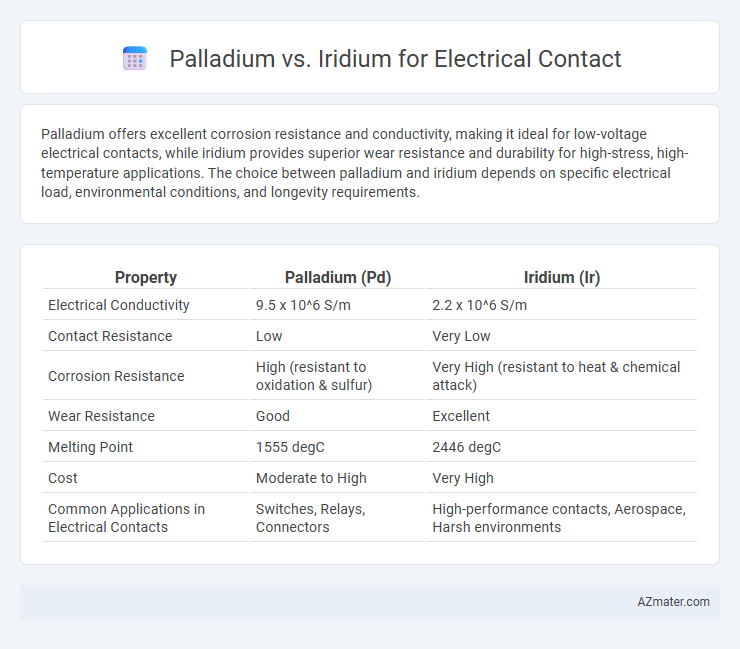Palladium offers excellent corrosion resistance and conductivity, making it ideal for low-voltage electrical contacts, while iridium provides superior wear resistance and durability for high-stress, high-temperature applications. The choice between palladium and iridium depends on specific electrical load, environmental conditions, and longevity requirements.
Table of Comparison
| Property | Palladium (Pd) | Iridium (Ir) |
|---|---|---|
| Electrical Conductivity | 9.5 x 10^6 S/m | 2.2 x 10^6 S/m |
| Contact Resistance | Low | Very Low |
| Corrosion Resistance | High (resistant to oxidation & sulfur) | Very High (resistant to heat & chemical attack) |
| Wear Resistance | Good | Excellent |
| Melting Point | 1555 degC | 2446 degC |
| Cost | Moderate to High | Very High |
| Common Applications in Electrical Contacts | Switches, Relays, Connectors | High-performance contacts, Aerospace, Harsh environments |
Introduction to Palladium and Iridium in Electrical Contacts
Palladium and iridium are transition metals extensively used in electrical contacts due to their excellent conductivity and resistance to corrosion. Palladium offers superior oxidation resistance and excellent electrical conductivity, making it ideal for low-current, high-reliability applications such as automotive and telecommunications switches. Iridium, one of the densest and most corrosion-resistant metals, provides exceptional durability and wear resistance, making it suitable for high-current and harsh-environment contacts, including spark plugs and industrial relays.
Physical and Chemical Properties Comparison
Palladium exhibits excellent oxidation resistance and high electrical conductivity, making it ideal for low-contact resistance in electrical contacts, while iridium offers superior hardness and corrosion resistance, enhancing durability under harsh environments. Palladium's melting point is 1554degC, significantly lower than iridium's 2446degC, affecting thermal stability during high-temperature applications. Chemically, palladium resists sulfur corrosion better, whereas iridium shows exceptional stability against acid and oxidation, influencing their selection based on operational conditions.
Electrical Conductivity: Palladium vs Iridium
Palladium exhibits higher electrical conductivity than iridium, making it more efficient for electrical contact applications where minimal resistance is crucial. Iridium, while highly corrosion-resistant, has lower conductivity, which may lead to increased energy loss in circuits. Choosing palladium enhances performance in low-voltage, high-frequency environments due to its superior electron flow properties.
Corrosion and Oxidation Resistance
Palladium exhibits excellent corrosion and oxidation resistance, making it highly suitable for electrical contacts in harsh environments, as it maintains conductivity and surface stability over time. Iridium offers superior oxidation resistance at elevated temperatures, ensuring long-term durability in high-stress electrical applications, though it is less commonly used due to higher cost and brittleness. Both metals provide reliable protection against corrosion, with palladium favored for low-to-moderate conditions and iridium preferred for extreme thermal and oxidative environments.
Wear and Durability Factors
Palladium and iridium are both valued for their excellent wear resistance and durability in electrical contacts, with palladium offering superior corrosion resistance and long-term stability under high current loads. Iridium's hardness provides exceptional wear resistance, making it ideal for applications involving frequent mechanical switching and harsh environmental conditions. The choice depends on specific wear mechanisms and environmental exposures, with palladium preferred for low-wear, corrosion-prone scenarios, while iridium suits high-wear, abrasion-intensive applications.
Cost and Availability in the Market
Palladium offers a more cost-effective solution compared to iridium, with prices typically lower due to higher market availability and more established mining operations. Iridium, rarer and less abundant, commands a premium price, reflecting its scarcity and intensive extraction processes. The extensive use of palladium in automotive and electronics industries ensures steady supply, whereas iridium's limited production restricts its widespread adoption despite superior corrosion resistance.
Common Applications in Electrical Contacts
Palladium and iridium are both critical in electrical contacts, with palladium favored for its excellent corrosion resistance and superior conductivity in low-current applications like switches and relays. Iridium's high melting point and robust wear resistance make it ideal for high-power environments, such as spark plugs and industrial contact points. Common applications highlight palladium's use in electronic connectors and iridium's role in heavy-duty electrical contacts requiring durability under extreme conditions.
Performance in High-Temperature Environments
Palladium exhibits excellent corrosion resistance and stable electrical conductivity at temperatures up to 200degC, making it suitable for moderate high-temperature electrical contacts. Iridium outperforms palladium in extreme high-temperature environments, maintaining conductivity and mechanical strength beyond 300degC due to its high melting point and superior oxidation resistance. For applications requiring long-term reliability under severe thermal stress, iridium offers enhanced performance and durability compared to palladium.
Environmental and Sustainability Considerations
Palladium offers superior corrosion resistance and conductivity, making it a preferred choice for electrical contacts in environmentally sensitive applications, while its mining process poses significant environmental challenges. Iridium, though rarer and more expensive, provides exceptional durability and stability under extreme conditions, reducing replacement frequency and associated waste. Sustainable sourcing initiatives and recycling efforts for both metals are critical to minimizing ecological impact and ensuring long-term supply security in the electronics industry.
Choosing the Right Metal: Palladium or Iridium for Your Application
Palladium offers excellent corrosion resistance and low electrical resistance, making it ideal for electrical contacts in consumer electronics and automotive sensors where reliable conductivity is critical. Iridium, known for its superior hardness and high melting point, is better suited for high-temperature, harsh environments such as aerospace and industrial applications requiring long-term durability. Selecting between palladium and iridium depends on factors like operating temperature, environmental exposure, and electrical performance requirements to ensure optimal contact reliability and lifespan.

Infographic: Palladium vs Iridium for Electrical Contact
 azmater.com
azmater.com